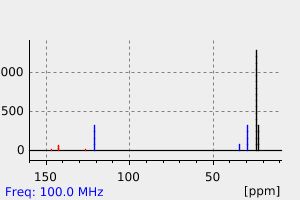2,4,6-triisopropylphenyl isocyanate | 401515-81-9
中文名称
——
中文别名
——
英文名称
2,4,6-triisopropylphenyl isocyanate
英文别名
2-isocyanato-1,3,5-tri(propan-2-yl)benzene
CAS
401515-81-9
化学式
C16H23NO
mdl
——
分子量
245.365
InChiKey
BOAYBOINRWNWJC-UHFFFAOYSA-N
BEILSTEIN
——
EINECS
——
-
物化性质
-
计算性质
-
ADMET
-
安全信息
-
SDS
-
制备方法与用途
-
上下游信息
-
文献信息
-
表征谱图
-
同类化合物
-
相关功能分类
-
相关结构分类
计算性质
-
辛醇/水分配系数(LogP):6.1
-
重原子数:18
-
可旋转键数:4
-
环数:1.0
-
sp3杂化的碳原子比例:0.56
-
拓扑面积:29.4
-
氢给体数:0
-
氢受体数:2
上下游信息
-
上游原料
中文名称 英文名称 CAS号 化学式 分子量 —— 2,4,6-triisopropylaniline 21524-36-7 C15H25N 219.37
反应信息
-
作为反应物:描述:2,4,6-triisopropylphenyl isocyanate 在 methylphospholene oxide 作用下, 生成参考文献:名称:METHOD FOR PRODUCING CARBODIIMIDES摘要:本发明涉及一种制备脲酰胺的新方法。公开号:US20200331849A1
-
作为产物:描述:1,3,5-triisopropyl-2-nitrobenzene 在 盐酸 、 锌 作用下, 以 1,4-二氧六环 、 溶剂黄146 为溶剂, 反应 3.0h, 生成 2,4,6-triisopropylphenyl isocyanate参考文献:名称:包含环庚三烯基站的假轮烷和轮烷 - 合成和共构象摘要:新型 [2] 轮烷含有四阳离子环双(百草枯-4,4'-亚联苯),机械连接到哑铃形分子线,结合一对二芳基环庚三烯单元,已以高达 35% 的中等产率合成酰化封端方法,使用大体积的酰氯或异氰酸酯。由富电子分子线穿过四阳离子环形成的假轮烷用 1H NMR 和 UV/Vis 光谱表征。非平面的船形环庚三烯环不会妨碍穿线过程。根据 1H NMR 谱,四阳离子环在轮烷中的两个环庚三烯站之间经历快速穿梭过程。环芳质子共振的意外信号分散归因于两种非对映体轮烷的存在。结果表明,识别位点之间的相互作用受七元环取代模式的强烈影响;缺电子环与 1,3-二芳基-2,4,6-环庚三烯单元之间的相互作用比与区域异构的 1,4-二取代侧基部分的相互作用强得多。DOI:10.1002/1099-0690(200110)2001:20<3921::aid-ejoc3921>3.0.co;2-z
文献信息
-
α-Substituted Malonester Amides: Tools To Define the Relationship between ACAT Inhibition and Adrenal Toxicity作者:Drago R. Sliskovic、Joseph A. Picard、Patrick M. O'Brien、Peggy Liao、W. Howard Roark、Bruce D. Roth、Maureen A. Anderson、Sandra Bak Mueller、Thomas M. A. Bocan、Richard F. Bousley、Katherine L. Hamelehle、Reynold Homan、James F. Reindel、Richard L. Stanfield、Daniel Turluck、Brian R. KrauseDOI:10.1021/jm970560h日期:1998.2.1evaluated for their ability to inhibit acyl-CoA:cholesterol O-acyl transferase activity in vitro and to lower plasma total cholesterol levels in a variety of cholesterol-fed animal models. Compounds of this series were also useful in examining the relationship between adrenal toxicity and ACAT inhibition. One compound from this series, 9f, was a potent inhibitor of ACAT in both the microsomal and cellular
-
Facile Synthesis of Sterically Hindered and Electron-Deficient Secondary Amides from Isocyanates作者:Gabriel Schäfer、Coraline Matthey、Jeffrey W. BodeDOI:10.1002/anie.201204481日期:2012.9.3The big easy: The direct coupling of Grignard reagents to isocyanates provides a facile and robust solution for the synthesis of sterically hindered and electron‐deficient secondary amides. The products are obtained in high yields without the need for excess reagents or chromatographic purification.
-
Carbodiimide aus trisubstituierten aromatischen Isocyanaten, ein Verfahren zu deren Herstellung und deren Verwendung申请人:Rhein Chemie Rheinau GmbH公开号:EP2520597A1公开(公告)日:2012-11-07Die Erfindung betrifft neuartige Carbodiimide, ein Verfahren zu deren Herstellung und deren Verwendung als Stabilisator, Vernetzer und/oder Kompatibilisator in Thermoplasten, esterbasierten Polyolen für Polyurethan-Anwendungen, in Hartschaum, in Weichschaum oder z.B. in CASE-Anwendungen (Coatings Adhesives Sealants Elastomers).
-
Verfahren zur Stabilisierung von Estergruppen-enthaltenden Polymeren申请人:Rhein Chemie Rheinau GmbH公开号:EP2671912A1公开(公告)日:2013-12-11Die Erfindung betrifft Verfahren zur Stabilisierung von Estergruppen-enthaltenden Polymeren, bei denen spezielle monomere aromatische Carbodiimide flüssigdosiert bei deren Herstellung und/oder deren Verarbeitung zugegeben werden.本发明涉及稳定含有酯基的聚合物的工艺,在生产和/或加工过程中,以液态剂量添加特殊的单体芳香族碳二亚胺。
-
HYDROLYSESTABILISIERTE POLYETHYLENTEREPHTHALAT (PET) - HALTIGE ZUSAMMENSETZUNGEN
表征谱图
-
氢谱1HNMR
-
质谱MS
-
碳谱13CNMR
-
红外IR
-
拉曼Raman
-
峰位数据
-
峰位匹配
-
表征信息
同类化合物
(βS)-β-氨基-4-(4-羟基苯氧基)-3,5-二碘苯甲丙醇
(S,S)-邻甲苯基-DIPAMP
(S)-(-)-7'-〔4(S)-(苄基)恶唑-2-基]-7-二(3,5-二-叔丁基苯基)膦基-2,2',3,3'-四氢-1,1-螺二氢茚
(S)-盐酸沙丁胺醇
(S)-3-(叔丁基)-4-(2,6-二甲氧基苯基)-2,3-二氢苯并[d][1,3]氧磷杂环戊二烯
(S)-2,2'-双[双(3,5-三氟甲基苯基)膦基]-4,4',6,6'-四甲氧基联苯
(S)-1-[3,5-双(三氟甲基)苯基]-3-[1-(二甲基氨基)-3-甲基丁烷-2-基]硫脲
(R)富马酸托特罗定
(R)-(-)-盐酸尼古地平
(R)-(-)-4,12-双(二苯基膦基)[2.2]对环芳烷(1,5环辛二烯)铑(I)四氟硼酸盐
(R)-(+)-7-双(3,5-二叔丁基苯基)膦基7''-[((6-甲基吡啶-2-基甲基)氨基]-2,2'',3,3''-四氢-1,1''-螺双茚满
(R)-(+)-7-双(3,5-二叔丁基苯基)膦基7''-[(4-叔丁基吡啶-2-基甲基)氨基]-2,2'',3,3''-四氢-1,1''-螺双茚满
(R)-(+)-7-双(3,5-二叔丁基苯基)膦基7''-[(3-甲基吡啶-2-基甲基)氨基]-2,2'',3,3''-四氢-1,1''-螺双茚满
(R)-(+)-4,7-双(3,5-二-叔丁基苯基)膦基-7“-[(吡啶-2-基甲基)氨基]-2,2”,3,3'-四氢1,1'-螺二茚满
(R)-3-(叔丁基)-4-(2,6-二苯氧基苯基)-2,3-二氢苯并[d][1,3]氧杂磷杂环戊烯
(R)-2-[((二苯基膦基)甲基]吡咯烷
(R)-1-[3,5-双(三氟甲基)苯基]-3-[1-(二甲基氨基)-3-甲基丁烷-2-基]硫脲
(N-(4-甲氧基苯基)-N-甲基-3-(1-哌啶基)丙-2-烯酰胺)
(5-溴-2-羟基苯基)-4-氯苯甲酮
(5-溴-2-氯苯基)(4-羟基苯基)甲酮
(5-氧代-3-苯基-2,5-二氢-1,2,3,4-oxatriazol-3-鎓)
(4S,5R)-4-甲基-5-苯基-1,2,3-氧代噻唑烷-2,2-二氧化物-3-羧酸叔丁酯
(4S,4''S)-2,2''-亚环戊基双[4,5-二氢-4-(苯甲基)恶唑]
(4-溴苯基)-[2-氟-4-[6-[甲基(丙-2-烯基)氨基]己氧基]苯基]甲酮
(4-丁氧基苯甲基)三苯基溴化磷
(3aR,8aR)-(-)-4,4,8,8-四(3,5-二甲基苯基)四氢-2,2-二甲基-6-苯基-1,3-二氧戊环[4,5-e]二恶唑磷
(3aR,6aS)-5-氧代六氢环戊基[c]吡咯-2(1H)-羧酸酯
(2Z)-3-[[(4-氯苯基)氨基]-2-氰基丙烯酸乙酯
(2S,3S,5S)-5-(叔丁氧基甲酰氨基)-2-(N-5-噻唑基-甲氧羰基)氨基-1,6-二苯基-3-羟基己烷
(2S,2''S,3S,3''S)-3,3''-二叔丁基-4,4''-双(2,6-二甲氧基苯基)-2,2'',3,3''-四氢-2,2''-联苯并[d][1,3]氧杂磷杂戊环
(2S)-(-)-2-{[[[[3,5-双(氟代甲基)苯基]氨基]硫代甲基]氨基}-N-(二苯基甲基)-N,3,3-三甲基丁酰胺
(2S)-2-[[[[[((1S,2S)-2-氨基环己基]氨基]硫代甲基]氨基]-N-(二苯甲基)-N,3,3-三甲基丁酰胺
(2S)-2-[[[[[[((1R,2R)-2-氨基环己基]氨基]硫代甲基]氨基]-N-(二苯甲基)-N,3,3-三甲基丁酰胺
(2-硝基苯基)磷酸三酰胺
(2,6-二氯苯基)乙酰氯
(2,3-二甲氧基-5-甲基苯基)硼酸
(1S,2S,3S,5S)-5-叠氮基-3-(苯基甲氧基)-2-[(苯基甲氧基)甲基]环戊醇
(1S,2S,3R,5R)-2-(苄氧基)甲基-6-氧杂双环[3.1.0]己-3-醇
(1-(4-氟苯基)环丙基)甲胺盐酸盐
(1-(3-溴苯基)环丁基)甲胺盐酸盐
(1-(2-氯苯基)环丁基)甲胺盐酸盐
(1-(2-氟苯基)环丙基)甲胺盐酸盐
(1-(2,6-二氟苯基)环丙基)甲胺盐酸盐
(-)-去甲基西布曲明
龙蒿油
龙胆酸钠
龙胆酸叔丁酯
龙胆酸
龙胆紫-d6
龙胆紫







